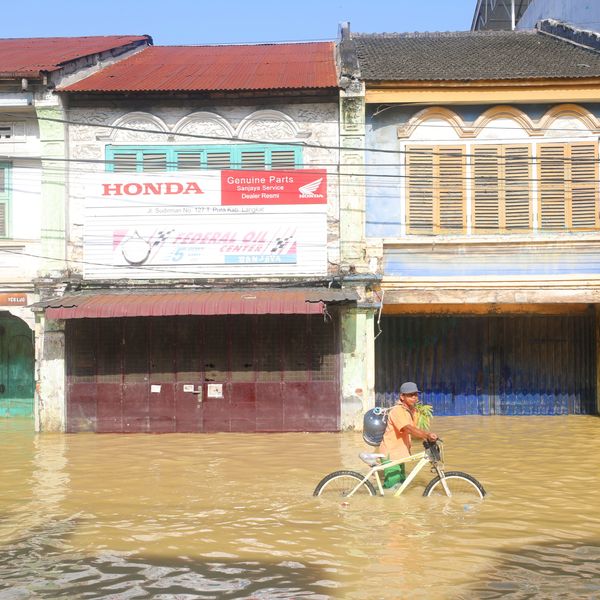'Warning for the World': Five Pacific Islands Officially Lost to Rising Seas
The event is the first official confirmation of what the future could be under climate change, researchers say
Five Pacific Islands have been swallowed by rising seas and coastal erosion, in what Australian researchers say is the first confirmation of what climate change will bring.
The submerged region, which was part of the Solomon Islands archipelago and was above water as recently as 2014, was not inhabited by humans.
However, a further six islands are also experiencing "severe shoreline recession," which is forcing the populations in those settlements--some of which have existed since at least 1935--to flee, according to a study published last week in Environmental Research Letters.
Researchers used aerial and satellite images dating back to 1947 to track coastal erosion across 33 islands. At least 11 islands across the northern region of the archipelago "have either totally disappeared over recent decades or are currently experiencing severe erosion," the study found.
"This is the first scientific evidence...that confirms the numerous anecdotal accounts from across the Pacific of the dramatic impacts of climate change on coastlines and people," the researchers wrote at Scientific American on Monday.
Lead author Dr. Simon Albert, a senior research fellow at the University of Queensland, told Agence France-Presse that rates of sea level rise in the Solomons are almost three times higher than the global average.
The five that sank ranged in size from one to five hectares (roughly two to 12 acres) and supported "dense tropical vegetation that was at least 300 years old," the researchers wrote for Scientific American, calling the event "a warning for the world."
Rates of sea level rise were substantially greater in areas exposed to high wave energy, the researchers found, "indicating a synergistic interaction between sea-level rise and waves."
That means islands exposed to higher wave energy in addition to sea level rise face faster and more widespread loss than sheltered islands.
They wrote:
These higher rates are in line with what we can expect across much of the Pacific in the second half of this century as a result of human-induced sea-level rise. Many areas will experience long-term rates of sea-level rise similar to that already experienced in Solomon Islands in all but the very lowest-emission scenarios.
Understanding the factors that put certain regions at greater risk for coastal erosion is vital to help frontline communities adapt, the study concluded.
The families that have already been forced to relocate did so using their own limited resources and received little to no assistance from their government or international climate funds, the researchers noted. The exodus had the additional impact of fragmenting established communities of hundreds of people.
Melchior Mataki, who chairs the Solomon Islands' Natural Disaster Council, told the researchers, "This ultimately calls for support from development partners and international financial mechanisms such as the Green Climate Fund. This support should include nationally driven scientific studies to inform adaptation planning to address the impacts of climate change in Solomon Islands."
The Solomon Islands were among the 175 nations that signed the Paris climate agreement in New York last month.
An Urgent Message From Our Co-Founder
Dear Common Dreams reader, The U.S. is on a fast track to authoritarianism like nothing I've ever seen. Meanwhile, corporate news outlets are utterly capitulating to Trump, twisting their coverage to avoid drawing his ire while lining up to stuff cash in his pockets. That's why I believe that Common Dreams is doing the best and most consequential reporting that we've ever done. Our small but mighty team is a progressive reporting powerhouse, covering the news every day that the corporate media never will. Our mission has always been simple: To inform. To inspire. And to ignite change for the common good. Now here's the key piece that I want all our readers to understand: None of this would be possible without your financial support. That's not just some fundraising cliche. It's the absolute and literal truth. We don't accept corporate advertising and never will. We don't have a paywall because we don't think people should be blocked from critical news based on their ability to pay. Everything we do is funded by the donations of readers like you. Will you donate now to help power the nonprofit, independent reporting of Common Dreams? Thank you for being a vital member of our community. Together, we can keep independent journalism alive when it’s needed most. - Craig Brown, Co-founder |
Five Pacific Islands have been swallowed by rising seas and coastal erosion, in what Australian researchers say is the first confirmation of what climate change will bring.
The submerged region, which was part of the Solomon Islands archipelago and was above water as recently as 2014, was not inhabited by humans.
However, a further six islands are also experiencing "severe shoreline recession," which is forcing the populations in those settlements--some of which have existed since at least 1935--to flee, according to a study published last week in Environmental Research Letters.
Researchers used aerial and satellite images dating back to 1947 to track coastal erosion across 33 islands. At least 11 islands across the northern region of the archipelago "have either totally disappeared over recent decades or are currently experiencing severe erosion," the study found.
"This is the first scientific evidence...that confirms the numerous anecdotal accounts from across the Pacific of the dramatic impacts of climate change on coastlines and people," the researchers wrote at Scientific American on Monday.
Lead author Dr. Simon Albert, a senior research fellow at the University of Queensland, told Agence France-Presse that rates of sea level rise in the Solomons are almost three times higher than the global average.
The five that sank ranged in size from one to five hectares (roughly two to 12 acres) and supported "dense tropical vegetation that was at least 300 years old," the researchers wrote for Scientific American, calling the event "a warning for the world."
Rates of sea level rise were substantially greater in areas exposed to high wave energy, the researchers found, "indicating a synergistic interaction between sea-level rise and waves."
That means islands exposed to higher wave energy in addition to sea level rise face faster and more widespread loss than sheltered islands.
They wrote:
These higher rates are in line with what we can expect across much of the Pacific in the second half of this century as a result of human-induced sea-level rise. Many areas will experience long-term rates of sea-level rise similar to that already experienced in Solomon Islands in all but the very lowest-emission scenarios.
Understanding the factors that put certain regions at greater risk for coastal erosion is vital to help frontline communities adapt, the study concluded.
The families that have already been forced to relocate did so using their own limited resources and received little to no assistance from their government or international climate funds, the researchers noted. The exodus had the additional impact of fragmenting established communities of hundreds of people.
Melchior Mataki, who chairs the Solomon Islands' Natural Disaster Council, told the researchers, "This ultimately calls for support from development partners and international financial mechanisms such as the Green Climate Fund. This support should include nationally driven scientific studies to inform adaptation planning to address the impacts of climate change in Solomon Islands."
The Solomon Islands were among the 175 nations that signed the Paris climate agreement in New York last month.
Five Pacific Islands have been swallowed by rising seas and coastal erosion, in what Australian researchers say is the first confirmation of what climate change will bring.
The submerged region, which was part of the Solomon Islands archipelago and was above water as recently as 2014, was not inhabited by humans.
However, a further six islands are also experiencing "severe shoreline recession," which is forcing the populations in those settlements--some of which have existed since at least 1935--to flee, according to a study published last week in Environmental Research Letters.
Researchers used aerial and satellite images dating back to 1947 to track coastal erosion across 33 islands. At least 11 islands across the northern region of the archipelago "have either totally disappeared over recent decades or are currently experiencing severe erosion," the study found.
"This is the first scientific evidence...that confirms the numerous anecdotal accounts from across the Pacific of the dramatic impacts of climate change on coastlines and people," the researchers wrote at Scientific American on Monday.
Lead author Dr. Simon Albert, a senior research fellow at the University of Queensland, told Agence France-Presse that rates of sea level rise in the Solomons are almost three times higher than the global average.
The five that sank ranged in size from one to five hectares (roughly two to 12 acres) and supported "dense tropical vegetation that was at least 300 years old," the researchers wrote for Scientific American, calling the event "a warning for the world."
Rates of sea level rise were substantially greater in areas exposed to high wave energy, the researchers found, "indicating a synergistic interaction between sea-level rise and waves."
That means islands exposed to higher wave energy in addition to sea level rise face faster and more widespread loss than sheltered islands.
They wrote:
These higher rates are in line with what we can expect across much of the Pacific in the second half of this century as a result of human-induced sea-level rise. Many areas will experience long-term rates of sea-level rise similar to that already experienced in Solomon Islands in all but the very lowest-emission scenarios.
Understanding the factors that put certain regions at greater risk for coastal erosion is vital to help frontline communities adapt, the study concluded.
The families that have already been forced to relocate did so using their own limited resources and received little to no assistance from their government or international climate funds, the researchers noted. The exodus had the additional impact of fragmenting established communities of hundreds of people.
Melchior Mataki, who chairs the Solomon Islands' Natural Disaster Council, told the researchers, "This ultimately calls for support from development partners and international financial mechanisms such as the Green Climate Fund. This support should include nationally driven scientific studies to inform adaptation planning to address the impacts of climate change in Solomon Islands."
The Solomon Islands were among the 175 nations that signed the Paris climate agreement in New York last month.

